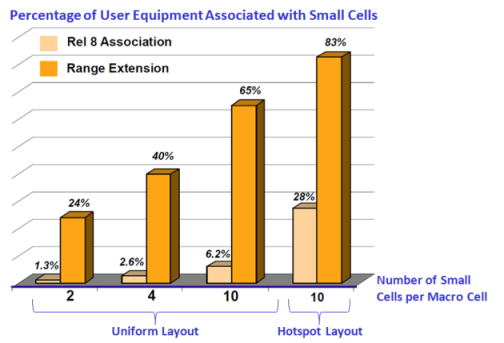 Small cells are meant as a solution to address the explosive growth in mobile data services, right? Well, the answer is: it depends! They can be a solution under certain conditions, but not always. Yes, there could be situations where small cells add little if any gain. In fact, more than one operator mentioned to me little or even no gain in overall capacity increase by their small cell pilot projects. So what’s happening, and why can we run into situations where small cells don’t deliver on their promise?
Small cells are meant as a solution to address the explosive growth in mobile data services, right? Well, the answer is: it depends! They can be a solution under certain conditions, but not always. Yes, there could be situations where small cells add little if any gain. In fact, more than one operator mentioned to me little or even no gain in overall capacity increase by their small cell pilot projects. So what’s happening, and why can we run into situations where small cells don’t deliver on their promise?
The culprit is that ‘cell edge’ problem which results when small cell base stations are deployed. The power imbalance between a small cell and a macrocell can be very high and reach as much as 30 dB. Consider a typical LTE macro base station transmitting 10 W of power and a small cell at a puny quarter or half watt. This is 13-16 dB difference. Add to this the difference in antenna gain which can be anywhere from 10-13 dB difference because the macrocell uses high gain directional antennas and the small cell a low gain omni-directional antennas and we’re pushing now close to 30 dB difference in effective radiated power. The power imbalance is experienced on the downlink path but not on the uplink path because the mobile device is all the same. The result is a significant imbalance between the downlink range of the small cell and the uplink range. This imbalance creates a small cell border region where interference can wreak havoc on network performance resulting in little or no capacity gain! Interestingly, the more small cells deployed, the more ‘cell edge’ regions are created. Add to this the potential of increased interference between the small cells themselves and you start to see the development of a real problem!

Small Cell Range Imbalance: Difference in Tx Power Between Macrocell and Small Cell Creates Large Imbalance Between Downlink and Uplink Range
But this problem is well known and understood. In fact, a major thrust of LTE evolution in standard activities is to find solutions to this problem. And solutions do exist; it’s just that vendors are not yet ready with commercial products that provide these fixes yet (nor are many operators ready to receive them). They will surely come, but for now, the first generation of LTE systems currently deployed (based on Release 8) is not equipped to deal in a serious manner with this problem. Until then, there are a number of key issues to note about small cell deployments, two of which are:
1- Small cells deployed in a uniform way will not provide much gain without features that fix the cell edge problem (see figure below).
2- In the absence of advanced interference management solutions, most capacity benefit will be obtained from deploying small cells in a targeted way with intimate knowledge of the location of traffic hotspot and interference profile. In other words, forget about mass uniform deployments for now. Planning will remain essential.

Percentage of User Equipment Associated with Small Cells. “Range Extension” Includes Techniques in Later LTE Releases to Mitigate Range Imbalance (Source: Qualcomm).
There are many other implications associated with this problem that are extremely interesting but unfortunately beyond the scope of this article. After all, complexity is what makes the hetnet architecture so interesting!
Pingback: More and More Small Cells, But Where’s the Gain? « ytd2525